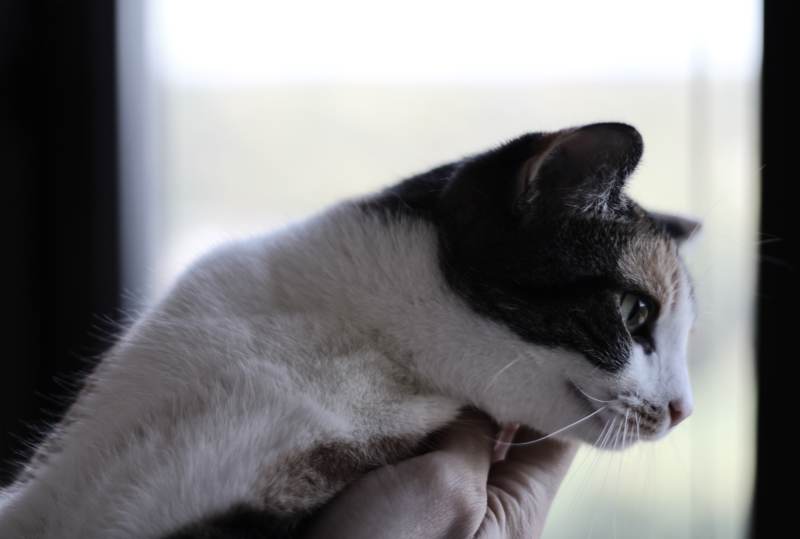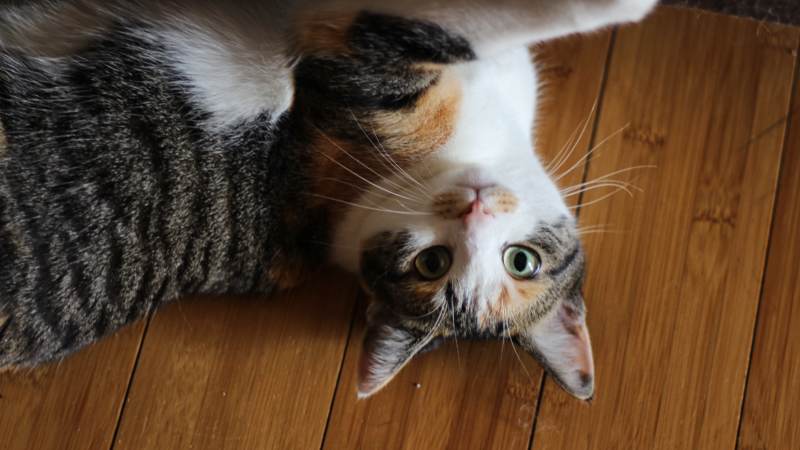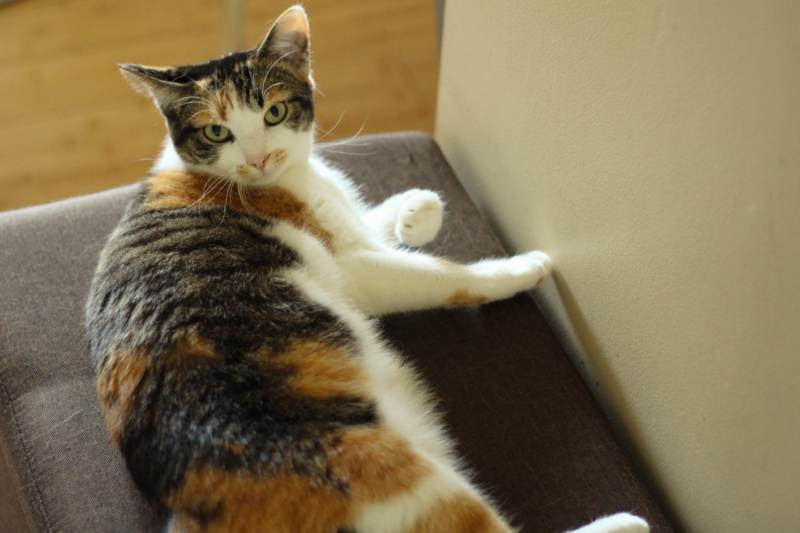Have you ever had your cat come to beg you for more food, even though their food bowl still has food? Has your cat only eaten the center of their food and is there still a ring of food around the rim of the bowl?
Well, you’re not alone.
I grew up in a Tupperware home, so all of my lunches were packed in Tupperware. My mom would always keep about a week of leftovers in Tupperwares, and still, our cupboards were filled with Tupperware.
Because of the surplus of Tupperware, whenever we needed to feed one of our cats out of something that wasn’t a feeder we would most likely choose to feed them out of a Tupperware.
At first, we were oblivious to the issues with using plastic bowls and containers as feeders. Luckily, we didn’t have to deal with any issues such as acne or allergies, but we did run into a whole different issue when we still fed our cats out of Tupperware.
It first started with our youngest cat, Kalista. When we first adopted her we didn’t have any extra pet-specific bowls for her to eat out of, because we were going to use some of Beau’s old puzzle feeders.
Since Kalista and Beau refuse to be separated and feeder toys are not ideal for two cats sharing the same space we moved on to using Tupperware again.
At first, we didn’t really care what Tupperware we used to feed Kalista. We rotated between a set of Tupperwares, one being a large square, one a small square and one medium rectangle. The large square container or the medium rectangle container were always used for wet food, while the small square was always for kibble.
We noticed that Kalista would happily eat out of the larger containers, however, whenever we put kibble in the smaller container she would always only eat the center of her food. Curious, as to maybe she wasn’t seeing the kibble, we tried the Tupperware with Beau to see if he would do the same, but no… he left the Tupperware spotless!
So we took a quick look at what was happening to Kalista while she ate and realized that her whiskers were being pushed up as she ate out of the small Tupperware, while in the larger ones her whiskers were being pushed up slightly if pushed up at all.

WHAT IS WHISKER FATIGUE & WHY DOES IT HAPPEN?
Cat’s whiskers are thick pieces of hair that are connected to the area above the eyes, your cat’s cheeks, chins, and even the back of their front legs.
Whisker fatigue commonly affects the cat’s face, in particular, the cheeks. This is due to the overstimulation and/or pressure placed on the cat’s whiskers while eating.
A cat’s whiskers are meant to be tools for collecting information as they are connected to a series of sensory collecting nerves. This is how cats are able to tell whether or not they are going to fit into a small space and why you should be nervous if your cat is losing a good amount of whiskers.
DOES WHISKER FATIGUE HURT?
No, whisker fatigue is not believed to be painful, although it can be extremely uncomfortable.
The best way to describe whisker fatigue is to call it an overload of information or sensations. The overload of information or sensation will often cause a cat to become stressed out or as mentioned, will cause them to become extremely uncomfortable.
SIGNS / SYMPTOMS OF WHISKER FATIGUE
Aggressive acting out around other pets during feeding time
Pawing at or removing food from the feeding container to the floor
Refusing to eat unless the food bowl is filled to the brim
Trying to spill the bowl (or even occurrences where the bowl is spilled)
Leftover food, often with just the center missing
Approaching feeder or food bowl with caution or second-guessing when eating food
Continous whining or meowing even though the food bowl has food
Excessive sneezes, wincing or scratching while eating
Shaking after taking a few bites of food
HOW DO I AVOID WHISKER FATIGUE?
Whisker fatigue can often be avoided simply by changing the food bowl you feed your cat out of.
Shallow bowls or bowls that don’t have brims are the most ideal. If you do get a bowl with a brim, make sure that it is either extremely shallow or has a small incline to make it easy to eat from. Think “saucer” instead of a bowl.

WHAT ARE THE BEST BOWLS TO REDUCE WHISKER FATIGUE?
Van Ness – Ecoware Cat Dish
When it comes to finding the most reasonably priced cat food dish you don’t have to look far to find this adorable gem.
The Vaness – Ecoware Cat Dish is a durable, whisker friendly cat dish that should always clear your cat’s whiskers.
Things I love about this dish include that it is made out of renewable and sustainable bamboo, that it is extremely shallow, and most importantly that it is BPA free!
Van Ness is also a reputable company and I’ve used many of their products. While the majority of the products I’ve used are their litterboxes, I have had zero complaints!
Dr. Catsby Cat Food Bowl
While I don’t necessarily believe that you’re going to need a “Doctor Approved Feeder” it is nice to know that it is around.
The Dr. Catsby Cat Food Bowl is a shallow, stainless steel cat bowl that should avoid hitting any cat’s whiskers. Not only that, but the fact that it is made out of stainless steel means that this bowl is going to be the most hygienic out of any plastics or even ceramics.
The greatest part of this cat bowl is the fact that it is dishwasher safe and has a non-skid mat that is included to ensure that your cat’s food doesn’t go slipping and sliding all over the place.
This bowl also has a 100% money-back guarantee if your cat does not like using it or if for whatever reason it continues to cause your cat whisker fatigue, you get your money back or a replacement!
Binkies Pet Supply Elevated Cat Bowl
I’m a really huge fan of elevated cat bowls, especially for older cats.
Elevated bowls make it a lot easier for your cat to be able to access their food, even if they are dealing with joint pain or arthritis. Elevated bowls also make it so a cat doesn’t have to bend down as much while eating, making it more comfortable in general for your cat to use.
Due to the fact that this bowl is raised, it will also make the chances of whisker fatigue minimum to none, simply due to the angle at which your cat will be eating their food. Though this is true, the same effect can be achieved by stacking your bowl on some books or on a yoga block.
Other perks of this product include that it is microwave and dishwasher safe as well as lead and cadmium free.
Petrageous Designs Here Kitty
I’m going to start off by saying, as adorable as this bowl is, I’m frustrated that you get whichever colour they send you and you have to live with it. Not that I care about what colours I use with my cats, but being that I have multiple cats it would be nice to colour code which of the bowls belongs to which cat.
Similar to all the bowls above, this bowl is shallow, but it features a ridiculously cute cat design, including ears and all!
This bowl is both dishwasher and microwave safe and follows FDA standards for lead.
lesotc Cat Food Bowl
The main difference between this cat bowl and the others is the fact that the back is raised while the front remains shallow. This is to prevent kibble (or water) from spilling out of the bowl while the cat is trying to eat.
From my understanding of this dish’s advertising, you receive both dishes for your purchase.
Lesotc bowls are lightweight, durable, dishwasher safe, toxin-free, but they are not microwave-safe. So, if you are a microwave family, you will either have to move onto using warm water to heat up your cat’s food or will have to choose a different bowl.
Lovinouse Upgraded Raised Cat Food Bowl
If you are new to the cat game and don’t know which size your cat is going to prefer, I would highly recommend grabbing one of these bowls.
For the most part, I think a bowl like this will be unnecessary, especially as you get accustomed to what your cat prefers, but I can’t deny that this is a well-designed bowl.
One side is designated for a shallow food bowl, holding about 4.5 oz of food, while the other side is designated for lots of water, holding about 9.8 oz of water.
The bowl has a slight slant to it to assure that it will miss all of your cat’s whiskers. It is also non-toxic.
That being said, I cannot tell whether or not it is dishwasher safe or microwave safe.

DO ALL VETS BELIEVE IN WHISKER FATIGUE?
Surprisingly, no. Whisker fatigue is a condition that many vets don’t agree on. The reason being: some vets believe that this overstimulation is not a problem for cats or that they don’t mind when it happens.
Now, though this may be true, there is evidence that some cats are very picky about their eating situations because they dislike the sensations caused by their whiskers being overly stimulated.
This is why one bowl doesn’t bother Beau at all, though Kalista gets frustrated when using it and has even refused to eat because no other option was provided.
WILL WHISKER FATIGUE EVER HARM A CAT?
No, whisker fatigue has not been known to ever harm a cat, other than in the moment discomfort.
If you ever notice your cat showing signs of pain or discomfort when they are not eating please contact the vet immediately. Due to the fact that many underlying illnesses have symptoms that are similar to whisker fatigue, your cat may be exhibiting signs of pain or discomfort because they are sick.
Whisker fatigue should not cause whiskers to fall out, though it is important to know that whiskers naturally fall out.
CONCLUSION
At the end of the day, whether or not you believe in whisker fatigue, the truth is the fact that each individual cat will have preferences. Some cats won’t mind their whiskers being bent by the side of bowls while others may refuse to eat altogether if provided with a bowl that they dislike.
in general, cats don’t need bowls to eat from and do just fine eating with plates. The main concern with feeding your cat from a plate is them spilling the food everywhere, or not being able to easily get the food because there’s no way to push the food into their mouths (though the latter is usually not a concern.)
If you have a feeling that your cat is experiencing stress or whisker tension from the bowl you’ve chosen to feed them out of it is highly recommended that you change the bowl to a flat plate or to a bowl that isn’t as deep. This will help alleviate any of the stress or overstimulation your cat may be experiencing and is quite a small price for the happiness of your cat.
While whisker fatigue is not a serious condition, disease or ailment, it should still be dealt with just to make sure that your cat is comfortable. This is especially true if you have a cat who refuses to eat on a regular occasion and for cats who get upset or stressed easily.
There should never be a moment where whisker fatigue must be treated by a vet, however, if your cat is showing any of the symptoms of whisker fatigue and the bowl isn’t to blame make sure to take your cat to the vet. Unfortunately, like many other conditions, whisker fatigue does share a number of symptoms to other underlying ailments.
In general, it’s also never a bad thing to have too many extra food bowls or dishes, especially because have been known to get picky out of the blue. I know Kalista was doing really well with eating for over a year, and only two weeks ago she started giving us troubles again!
So pet parents, I’m curious, have any of your cats experienced whisker fatigue before? What did you do to resolve it? Do you have a favourite bowl or feeder you use with your cats? Let me know in the comments below!
Pipo has some miniature pie plates that he likes to eat from…those were in the house long before I was married and had even thought about a kitty eating from them, MOL! They are ceramic. I bought him some stainless steel shallow kitty bowls and he did not like them. Not sure why…
He also has some of those petrageous bowls, a green one and a yellow one. Those came from our local store.
He likes to drink from a very large stainless steel bowl. He drinks from the edge, but mostly he is a dipper! He puts his paw in the water and licks it off…over and over again, till he’s had enough. I had to put the fountains away, because he made such a mess with them…go figure.
I should see how he will do if I elevate the bowls, say with a heaver one underneath?
I think I remember you telling me that Pipo was making a big mess with the fountain. I’m happy ours don’t make a mess with it because it seems to be the only thing Kalista will drink out of these days.
I’ve never met a dipper before! As messy as it sounds, it must be so cute to watch <3
I should take a video sometime, but he is so camera shy and I do not want to thwart his drinking, or make him reluctant to use the bowls. Esp as he is a senior and has enough issues going on…but it is cute to see. He of all my 6 kitties is the only consistent ‘dipper’.
Who knows maybe one day I’ll end up adopting my own dipper!
My cats’ favorite seems to be the Petrageous Designs oval cat face bowl. I’ve got a whole slew of them. I believe they come in a total of five different designs (that I’ve seen anyway), pink sleeping, blue sleeping, black with eyes open, white with eyes open, and white with a cat wearing shades. Some brick and mortar pet stores in the US including Petco carry them so you can choose the design, or otherwise there are separate Amazon listings for specific designs, and Chewy carries them as well.
Petrageous makes so many cute dishes! I can’t make my mind up for which are the best! Good to know that in the US some stores carry them. It seems like there are so many things we just don’t get in stores here. Sometimes you’re lucky if it’s on amazon though!
Thanks for the article. I have always wondered about this.
Absolutely no problem! Hope it helped give you all the info you needed 😀